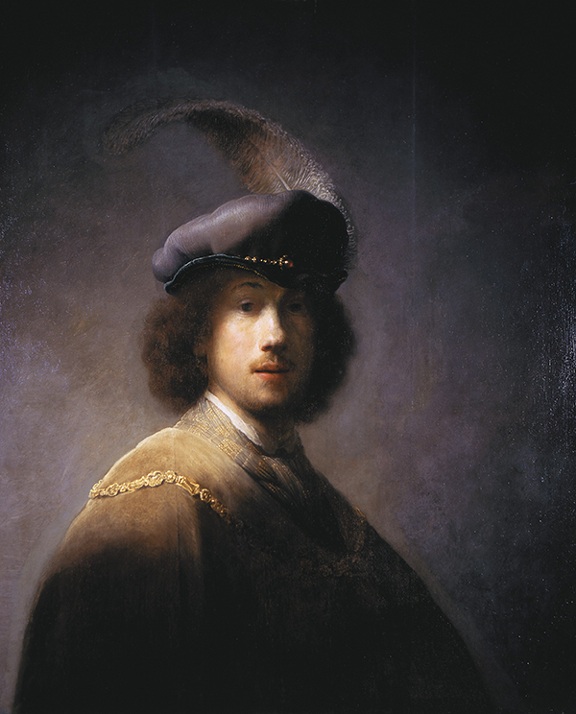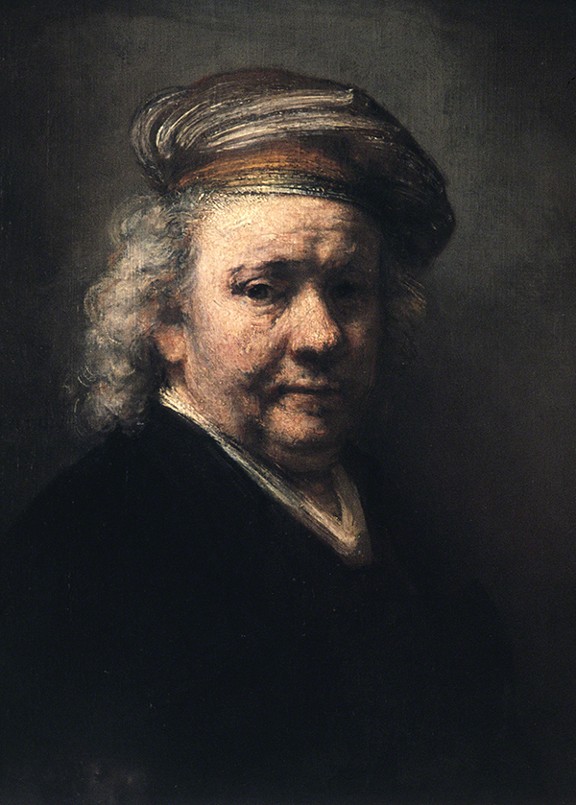Celebrating Rembrandt's Birthday
As one of the most remarkable talents of the Dutch Golden Age of painting, Rembrandt had the distinction of becoming a fantastically successful artist. Although his contemporaries raved about him, Rembrandt saw his fame slip away as he grew older, dying penniless in 1669. In Western art history, he is widely considered one of the most important artists. Rembrandt’s many self-portraits are certainly among the most recognizable subjects among his large body of work. Today, let's celebrate the anniversary of Rembrandt's birth on 15 July 1606 through two self-portraits produced at the beginning and end of his career.
 |
| Rembrandt van Rijn (1606–1669, Netherlands), Self-Portrait, Aged 23, 1629. Oil on wood, 35 ¼" x 29" (89.7 x 73.5 cm). © 2024 Isabella Stewart Gardner Museum, Boston, Purchased from Lieutenant Colonel Sawyer, through Bernard Berenson. (GM-39) |
By 1629, Rembrandt had already attracted attention as a history and portrait painter. This is an early self-portrait. The high amount of finish to the portrait, lack of any overt expression, and depiction of himself in elegant clothing suggests that it was a piece meant to sell his services to patrons looking for portraits. Out of almost 100 self-portraits Rembrandt produced during his lifetime, almost 40 were painted, providing a record of his appearance and often how he was feeling.
Rembrandt painted more self-portraits than any other European painter of the 1600s. His unique method of blending colors created a smoky, soft contour that heightened the dramatic contrast of lights and darks, so important to the Baroque penchant for drama. His self-portraits are inevitably a three-quarters view of the face and bust length, often as a monumental pyramidal composition. The shadows of the figure often merge with the background shadows. His features emerge as an almost interior light-source from the darkness.
Dutch art of the Baroque period maintained the same ideals of naturalism and detail as Northern Renaissance painting. However, in contrast to Catholic countries, Dutch artists developed their own hierarchy of subjects and styles, reflecting their reformed religion and the absence of a dominating church. Calvinistic Protestantism swept away any classical, historical, or religious subjects, emphasizing the predominant middle-class culture.
While some religious subjects persisted, portraiture, genre scenes, landscape, and still life became the predominant subjects. Dutch Baroque painting united the realism of Jan van Eyck (1390–1441) with the new realism of light and dark brought back by Dutch artists who had studied Caravaggio’s (1571–1610) style in Italy. In Dutch Baroque painting, the whole visual world was explored in scrupulous faithfulness.
Rembrandt was born in Leiden, the son of a miller and the youngest son of at least ten children. His family sent him to the Leiden Latin School, where he remained for seven years. In 1620, he enrolled briefly at the University of Leiden, perhaps to study theology, but he left the University to study the fundamentals of painting with the Leiden artist Jacob Isaacsz. van Swanenburgh (1571–1638). After three years, Rembrandt left for Amsterdam in 1624, where he studied for six months under Pieter Lastman (1583–1633), the most important history painter of the day.
After returning to Leiden, Rembrandt quickly developed a reputation as a history painter and portraitist. By 1628, his work was admired for his uncanny ability to convey feeling through gesture and expression and through dramatic contrasts of light and dark. That same year—at the age of twenty-two—Rembrandt took on his first pupils, Gerard Dou (1613–1675) and Isaac Jouderville (1612–1645/1648). Documents indicate that Jouderville paid Rembrandt 100 guilders a year to study with him. In 1632, he moved to Amsterdam and ran Hendrick van Uylenburgh's (1587–1661) “academy.” By 1635, he had achieved great success, so much so that artists who had been trained by other painters went to Uylenburgh's academy for Rembrandt’s guidance.
The mid- to late 1630s were the period of Rembrandt's greatest success. He married Saskia van Uylenburgh (1612–1642), the wealthy niece of Hendrick van Uylenburgh, and bought a house in Amsterdam. However, Rembrandt’s happiness was short lived. Three of his four children died in infancy and Saskia died in 1642, the year he painted his most famous painting, The Night Watch (Officers and other civic guardsmen of District II in Amsterdam, under the command of Captain Frans Banninck Cocq and Lieutenant Willem van Ruytenburch).
The 1640s marked the beginning of financial difficulties for Rembrandt. He was in debt from buying his large house and owed money to an art dealer. It was also a period of personal difficulties, which eventually ended when he met Hendrickje Stoffels (1626–1663) in 1649. The couple had a daughter, Cornelia, in 1654.
Although Rembrandt had several important portrait commissions during the 1650s and 1660s, public taste had moved away from his extremely dramatic and personal style of painting. By 1656, he had to declared bankruptcy and his house and personal art collection were auctioned off. He then moved into a small house in an artists’ quarter of Amsterdam, where he spent the rest of his life. He never really recovered from these difficulties, never again finding solvency. No students were recorded to have been his pupils from the mid-1650s on. When he died, he was buried in an unknown, rented grave.
 |
| Rembrandt van Rijn (1606–1669, Netherlands), Self-Portrait, 1669. Oil on canvas, 23 ¼" x 20 ⅞" (59 x 53 cm). Mauritshuis, The Hague, Netherlands. Image © 2024 Dr Ronald Wiedenhoeft/Saskia, Ltd. (MHF-0256) |
Rembrandt may have desired the look of a scholarly painter in this portrait. Painted in the month before he died, this is probably one of Rembrandt’s last self-portraits. Having suffered severe financial reverses in 1659, his expression reflects a lifetime of hard experiences endured with dignity. There is something of a weariness in his eyes.
Like most of his portraits, the sharp contrast of dark and light emphasizes the face, with the figure almost merging with the dark background. The paint is thickly and broadly applied, creating a lively, textured surface. This "spotlight" type of portrait—in which there are extreme contrasts in light and dark, an stylistic trait called tenebrism—remained popular in the Netherlands through the 1600s, and was the trademark of Amsterdam painters.
Correlations to Davis programs: Explorations in Art 2E Grade 1: 2.1; Explorations in Art 2E Grade 2: 2.3; Explorations in Art 2E Grade 3: 1.1; Explorations in Art 2E Grade 6: 1.9; Experience Art: 3.2; A Global Pursuit 2E 2.3

Comments